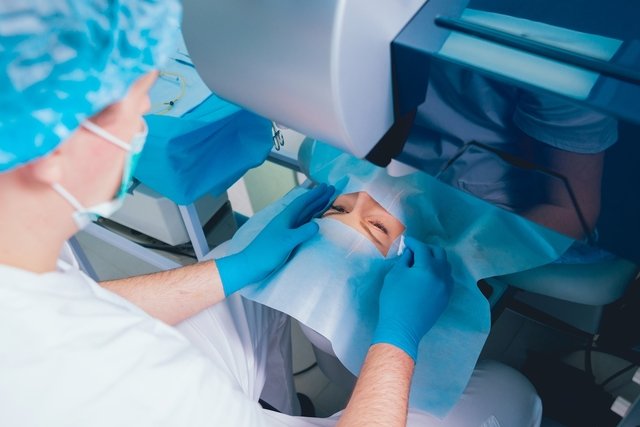Refractive surgery is indicated to treat vision problems such as myopia, hyperopia, astigmatism or presbyopia, allowing vision to be corrected or improved.
There are several types of refractive surgery, the most common of which is Lasik surgery, indicated for myopia, astigmatism or hyperopia, and which consists of using a laser to modify the curvature of the cornea, improving the way the eye focuses images, allowing a better view.
Refractive surgeries are performed by an ophthalmic surgeon and are safe and effective procedures, which can allow the person to stop wearing glasses or contact lenses, depending on the type of vision problem being treated.

What is it for
Refractive surgery is recommended by an ophthalmologist to treat vision problems such as:
- Myopia;
- Astigmatism;
- Hyperopia;
- Myopia with astigmatism;
- Hyperopia with astigmatism;
- Presbyopia.
It is important to consult an ophthalmologist to identify the type of vision problem and recommend the best type of refractive surgery.
Types of refractive surgery
The main types of refractive surgery are:
1. Cirurgia Lasik
Lasik surgery is the type of refractive surgery most used by ophthalmologists and is recommended to treat common vision problems such as myopia, astigmatism or hyperopia. This surgery takes just 5 minutes on each eye and the laser is applied for about 8 seconds, with the person awake and fully conscious. Anesthetics are applied in the form of eye drops minutes before surgery so that the person does not feel pain or discomfort.
How it is done: LASIK surgery consists of making a small opening (flap) on the superficial layer of the cornea in the eye, to remove a small layer of tissue from the eye and apply the laser to the cornea, modifying its curvature, improving the way the eye focuses images and allowing better vision.
Recovery: This type of surgery has a quick recovery, and usually only causes discomfort or mild pain in the eyes in the first 24 hours, or dry eyes. Therefore, after surgery, the ophthalmologist may recommend the use of eye drops to alleviate discomfort.
Furthermore, it is common for the appearance or increase of sensitivity to light, especially in the first few days. For this reason, activities that rely heavily on vision, such as driving, should be avoided immediately after surgery.
2. PRK Surgery
PRK surgery, also called photorefractive keratectomy, allows you to correct the degree of vision problems such as mild to moderate myopia, hyperopia or astigmatism, using a laser that corrects the curvature of the cornea. Generally, this surgery is recommended by the ophthalmologist for people who have a thinner cornea.
How it is done: Like LASIK surgery, PRK surgery uses a laser to correct the vision problem. The technique consists of removing the thinnest and most superficial layer of the cornea, to apply the laser, which is controlled by a computer to map the surface of the eye and calculate the amount of tissue that must be removed, allowing the correction of the curvature of the cornea and improving the vision. Understand better how PRK surgery is performed.
Recovery: This type of refractive surgery has a slower recovery than Lasik, usually 3 to 5 days, and can cause side effects such as eye pain that can last several weeks, blurred vision, or glare or halos around lights.
3. Ceratotomia
There are two types of keratotomy surgery that can be performed by an ophthalmologist, one for myopia, called radial keratotomy, and another to correct astigmatism, called astigmatic keratotomy.
Keratotomy surgeries aim to change the shape of the cornea, and the technique used is the same, but the way the cut is made in the cornea is different.
How it is done: Keratotomy is made through a deep cut in the cornea using a diamond scalpel, a stainless steel blade or laser, to change the shape of the cornea and correct the vision problem.
Recovery: This type of surgery is considered safe and effective, but has been replaced by LASIK surgery, due to the shorter recovery time and lower risk of complications, such as corneal rupture, cataracts or loss of vision, for example.
4. Phakic intraocular lens
Phakic intraocular lens refractive surgery is indicated for cases of severe myopia or hyperopia, in people who have high degrees or very curved or thin corneas, allowing a better correction of the vision problem than surgeries using laser.
This type of refractive surgery lasts around 30 minutes for each eye, and allows a corrective lens to be permanently placed inside the eye, which can be rigid or flexible, depending on each case.
How it is done: This surgery is performed through a small cut in the eye to place the lens, which can be implanted in front or behind the iris, which is the colored part of the eye, improving the vision problem.
Recovery: This surgery has a quick and safe recovery, but exertion or physical activity should be avoided for at least 15 days after surgery, to avoid complications such as infection or swelling of the cornea, for example.
How to prepare for surgery
Preparation for refractive surgery must include several exams such as topography, pachymetry, corneal mapping, pressure measurement and pupil dilation. In some cases, there are other tests that may also be necessary, such as corneal tomography or ocular aberrometry.
General recovery care
Recovery from refractive surgery is quite quick and on the same day the person can see everything without needing glasses or contact lenses. However, to guarantee the best possible result, there are some precautions that must be maintained during the first month, such as:
- Do not rub your eyes for at least 15 days;
- Clean the eyes with gauze and saline solution daily;
- Always keep your hands clean;
- Use eye protection for the time indicated by the doctor;
- Rest and rest to recover faster;
- Use the eye drops recommended by your doctor;
- Do not enter the pool or the sea;
- Do not wear makeup for 30 days;
- Wear sunglasses.
In the first 6 hours after surgery, the ideal is for the person to rest lying on their back so as not to put pressure on their eyes. Furthermore, in the first month, it is recommended to avoid going to places with lots of people and little air circulation, such as cinemas or shopping malls, to reduce the risk of infections.
Possible complications
Refractive surgery is considered very safe, however, as with any type of surgery, some complications may occur such as:
- Eye inflammation;
- Worsening of vision problems;
- Superficial scar on the cornea;
- Swelling in the cornea;
- Eye infection;
- Blurred vision or loss of vision;
- Sensitivity to light;
- See circles around lights;
- Weakening of the cornea;
- Cataract.
It is important to follow up with an ophthalmologist after refractive surgery, so that the doctor can identify any type of complication and initiate the most appropriate treatment, which may involve the use of eye drops to lubricate the eyes, corticosteroids or antibiotics, for example.
Who should not have surgery
Refractive surgeries are not recommended for those who have not yet turned 18, in case of pregnancy and also in case of:
- Very thin cornea;
- Keratoconus;
- Autoimmune disease, such as rheumatoid arthritis or lupus;
- Ocular herpes or other eye infections;
- While using medications such as isotretinoin for acne.
If you intend to correct vision problems, you should consult an ophthalmologist to indicate the best type of treatment.

Sign up for our newsletter and stay up to date with exclusive news
that can transform your routine!
Warning: Undefined array key "title" in /home/storelat/public_html/wp-content/plugins/link-whisper-premium/templates/frontend/related-posts.php on line 12
Warning: Undefined array key "title_tag" in /home/storelat/public_html/wp-content/plugins/link-whisper-premium/templates/frontend/related-posts.php on line 13



